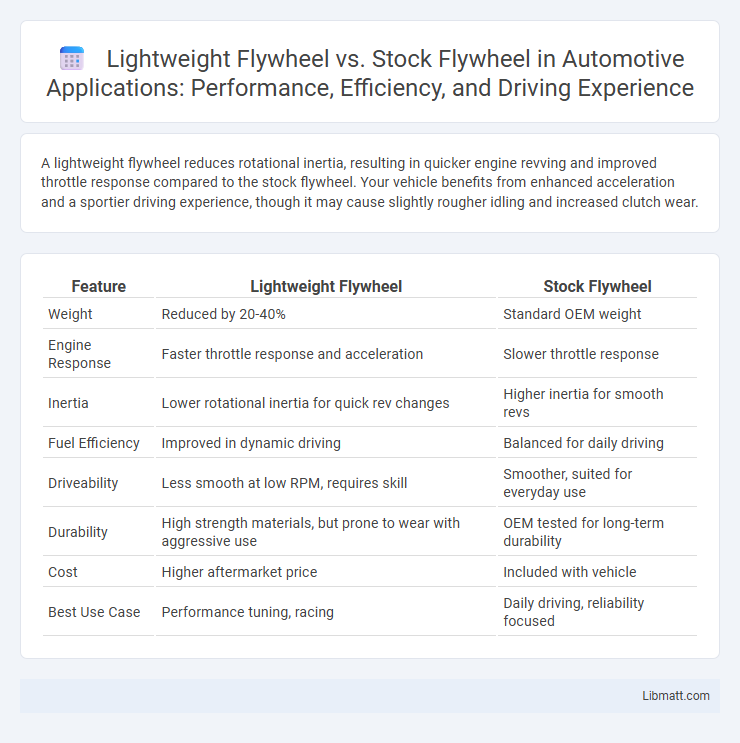A lightweight flywheel reduces rotational inertia, resulting in quicker engine revving and improved throttle response compared to the stock flywheel. Your vehicle benefits from enhanced acceleration and a sportier driving experience, though it may cause slightly rougher idling and increased clutch wear.
Table of Comparison
| Feature | Lightweight Flywheel | Stock Flywheel |
|---|---|---|
| Weight | Reduced by 20-40% | Standard OEM weight |
| Engine Response | Faster throttle response and acceleration | Slower throttle response |
| Inertia | Lower rotational inertia for quick rev changes | Higher inertia for smooth revs |
| Fuel Efficiency | Improved in dynamic driving | Balanced for daily driving |
| Driveability | Less smooth at low RPM, requires skill | Smoother, suited for everyday use |
| Durability | High strength materials, but prone to wear with aggressive use | OEM tested for long-term durability |
| Cost | Higher aftermarket price | Included with vehicle |
| Best Use Case | Performance tuning, racing | Daily driving, reliability focused |
Introduction to Flywheels
Flywheels store rotational energy to stabilize engine speed during combustion cycles. A lightweight flywheel reduces rotational mass, allowing quicker acceleration and deceleration, enhancing throttle response. Your choice between a lightweight and stock flywheel impacts engine smoothness, with stock flywheels offering greater inertia for steadier idle and reduced stalling.
What is a Lightweight Flywheel?
A lightweight flywheel is a performance automotive component designed to reduce rotational mass, allowing the engine to rev more quickly and improve throttle response compared to a stock flywheel. Typically constructed from lighter materials like aluminum or magnesium, it decreases inertia and enhances acceleration while maintaining sufficient momentum for smooth engine operation. Compared to stock flywheels made of heavier steel, lightweight flywheels provide better gearbox engagement and quicker engine speed changes, making them popular in racing and high-performance vehicles.
Stock Flywheel: Definition and Purpose
A stock flywheel is the original equipment manufacturer (OEM) component designed to store rotational energy and maintain engine momentum during combustion cycles. Its primary purpose is to smooth out power delivery, assist in starting the engine, and reduce vibration, ensuring optimal drivability and engine stability. Your vehicle's stock flywheel balances durability with consistent performance, making it suitable for everyday driving conditions.
Performance Benefits of Lightweight Flywheels
Lightweight flywheels reduce rotational mass, enabling the engine to rev more quickly and improve throttle response for enhanced acceleration. By decreasing inertial resistance, lightweight flywheels increase engine responsiveness, particularly in high-performance and racing applications. This results in smoother gear shifts and more efficient power delivery compared to stock flywheels.
Pros and Cons of Stock Flywheels
Stock flywheels offer durability and smooth engine performance due to their heavier mass, which aids in maintaining consistent momentum during low RPMs. However, their weight results in slower engine response and reduced acceleration compared to lightweight flywheels. Your choice will depend on whether you prioritize reliability and smooth idling or quicker throttle response and higher revving capabilities.
Acceleration and Throttle Response Comparison
A lightweight flywheel reduces rotational mass, allowing the engine to rev more quickly and significantly improving throttle response and acceleration times compared to a stock flywheel. By decreasing the inertia, the engine can change speeds faster, enhancing the vehicle's responsiveness during rapid throttle changes or gear shifts. While this upgrade boosts performance, drivers may experience a slightly rougher idle or increased vibration due to the reduced mass.
Impact on Drivability and Daily Use
Lightweight flywheels reduce rotational mass, resulting in faster engine response and quicker acceleration, enhancing overall drivability for spirited driving. However, they may cause less smooth idle and require more clutch modulation, which can be less comfortable in daily stop-and-go traffic. Stock flywheels provide smoother engine operation and better inertia for low-speed stability, making them more suitable for regular commuting and daily use.
Fuel Efficiency Considerations
A lightweight flywheel reduces rotational mass, allowing your engine to rev more freely and respond quicker, which can lead to improved fuel efficiency during stop-and-go driving. Stock flywheels, being heavier, maintain momentum better at constant speeds but require more energy to accelerate, potentially consuming more fuel in city driving conditions. Choosing a lightweight flywheel can optimize your vehicle's fuel consumption by minimizing engine load during acceleration phases.
Installation and Compatibility Issues
Lightweight flywheels often require precise installation due to their reduced mass and different balance characteristics compared to stock flywheels, which can affect engine timing and clutch engagement. Compatibility issues arise as lightweight flywheels may not fit all makes or models without modifications to the clutch assembly or flywheel bolts. Your vehicle's performance and reliability depend on ensuring the lightweight flywheel matches the original specifications and is installed with proper torque and alignment.
Choosing the Right Flywheel for Your Needs
Lightweight flywheels reduce rotational mass, allowing for faster engine revving and improved throttle response, making them ideal for performance enthusiasts and track use. Stock flywheels offer greater inertia, providing smoother acceleration and easier drivability in daily use or city driving conditions. Selecting the right flywheel depends on balancing desired engine responsiveness with vehicle usability and driving habits.
lightweight flywheel vs stock flywheel Infographic

 libmatt.com
libmatt.com